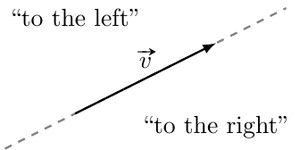The cross product \(\vec{v} \times \vec{w}\) of two vectors \(\vec{v}\) and \(\vec{w}\) can be seen as a measure of how perpendicular they are.
It is defined in 2D as:
where \(\|\vec{v}\|\) and \(\|\vec{w}\|\) are the lengths of the vectors and \(\theta\) is the amplitude of the oriented angle from \(\vec{v}\) to \(\vec{w}\).
The cross product has a very simple expression in cartesian coordiantes. If \(\vec{v} = (v_x, v_y)\) and \(\vec{w} = (w_x, w_y)\) then
static double cross(Point v, Point w) {
return v.x * w.y - v.y * w.x;
}
Geometric interpretation
The cross product \(\vec{v} \times \vec{w}\) can be seen as a measure of how perpendicular the two vectors are.
The sign of the cross product indicates whether \(\vec{w}\) is to the left or to the right of \(\vec{v}\).
- \(\vec{v} \times \vec{w} > 0\): \(\vec{w}\) is to the left of \(\vec{v}\)
- \(\vec{v} \times \vec{w} < 0\): \(\vec{w}\) is to the right of \(\vec{v}\)
- \(\vec{v} \times \vec{w} = 0\): \(\vec{w}\) and \(\vec{v}\) are aligned

In general, we take the angle between the vectors \(\theta\) in \(]-\pi, \pi]\) so that the dot product is positive if \(0 < \theta < \pi\), negative if \(-\pi < \theta < 0\) and zero if \(\theta = 0\) or \(\theta = \pi\):

 INGInious
INGInious